-
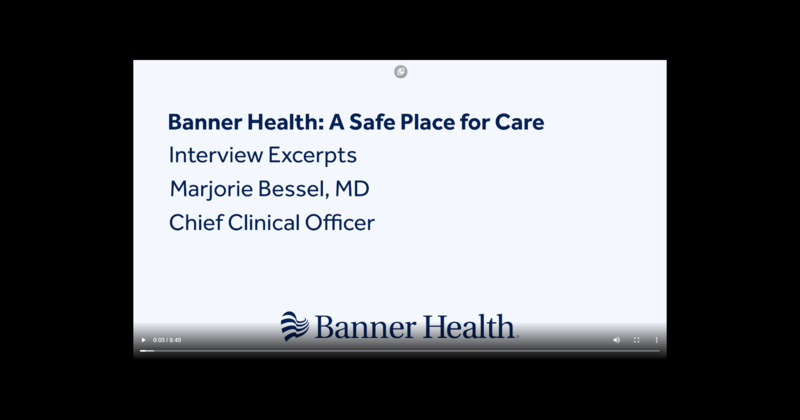
07/22/2021
Chief Clinical Officer Marjorie Bessel, MD, outlines ways Banner Health is ensuring our facilities are a safe place for care for patients. Changes include using thermal cameras to detect fevers and continuous masking.
-
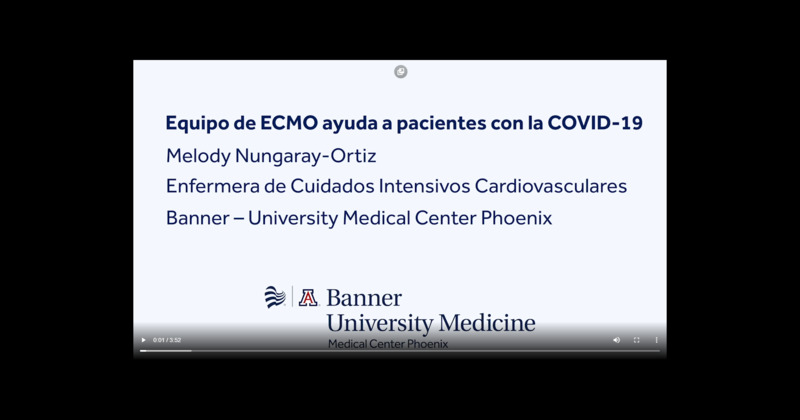
07/22/2021
Entrevista con Melody Nungaray-Ortiz en Español. Nungaray-Ortiz es una miembra del equipo de ECMO en Banner – University Medical Center Phoenix.
-
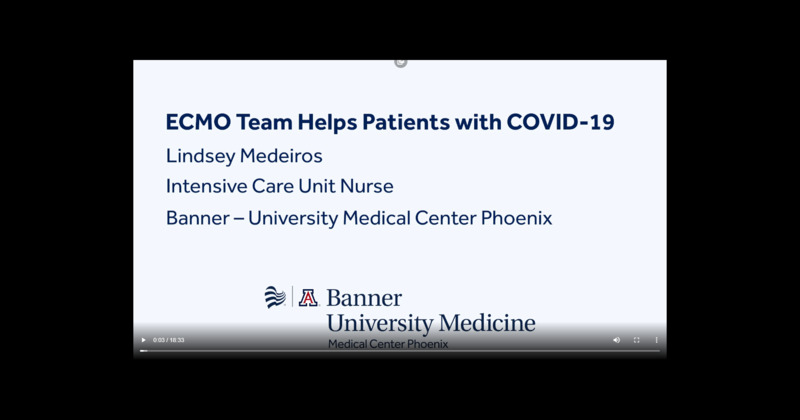
07/22/2021
Interviews with members of the ECMO team at Banner – University Medical Center Phoenix describe efforts underway to treat patients with severe symptoms associated with COVID-19.
-

07/22/2021
Nurses, respiratory therapists, physicians and others throughout Banner Health work around the clock to care for patients with COVID-19. B-Roll available for download, editing and broadcast.
-
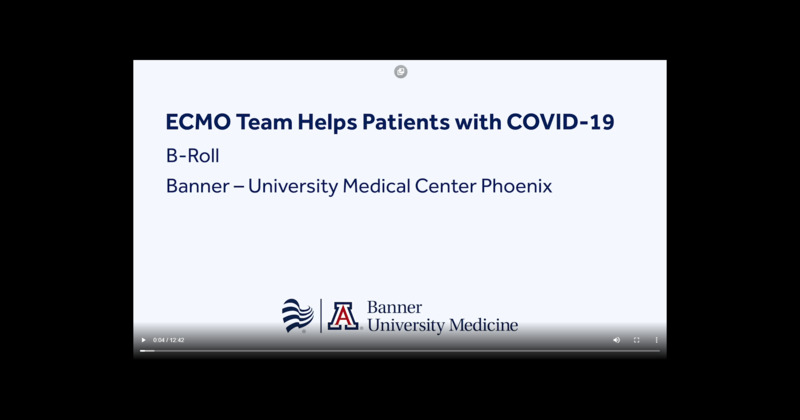
07/22/2021
Members of the ECMO team at Banner – University Medical Center Phoenix show how they use special equipment to stabilize and treat patients who are unable to maintain blood oxygen levels.
-

07/22/2021
Banner Health team members administer COVID-19 tests at the Arizona State Fairgrounds. B-Roll is available for download, editing and broadcast. More info: http://bannerhealth.mediaroom.com/COVID-19info
-
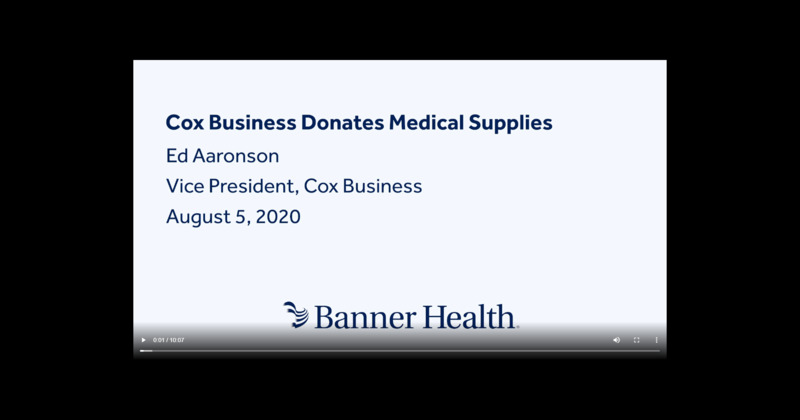
08/05/2020
Cox Business donate more than $200,000 worth of filtration and surgical masks. Community partners such as Cox Business continue to show their support for Banner Health's frontline health care workers.
-

07/22/2021
Banner Health experts are encouraging cardiac screenings for student-athletes as new research has revealed potential heart damage as a potential after effect from COVID-19 infection.
-
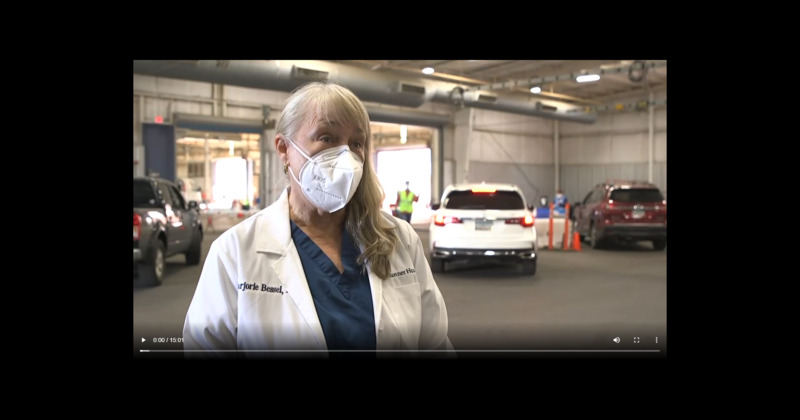
07/22/2021
Marjorie Bessel, MD, chief clinical officer of Banner Health, is on site at Arizona State Fairgrounds where Banner is administering thousands of vaccines.
-
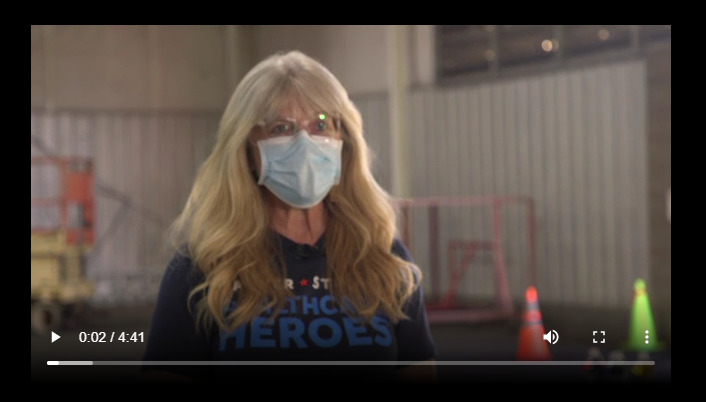
07/22/2021
Interview with Nancy Zismann, chief clinical services officer, Banner Health Zismann talks about Banner's vaccine operations. As of Feb. 5, 2021, Banner has provided more than 130,000 vaccines.
-
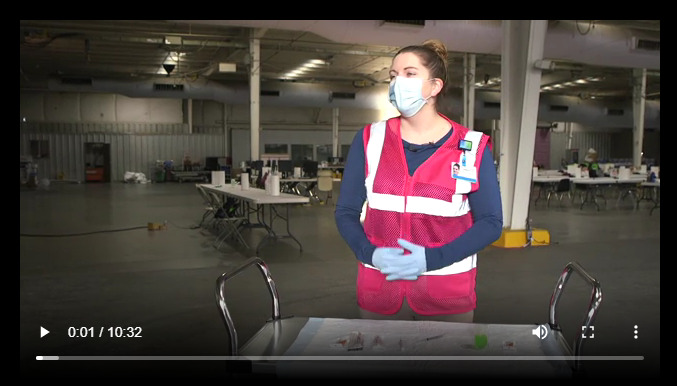
07/22/2021
Samantha Chapman, Ambulatory Pharmacy Operations coordinator, speaks about how Banner prepares and handles vaccines administered at Arizona State Fairgrounds.
-
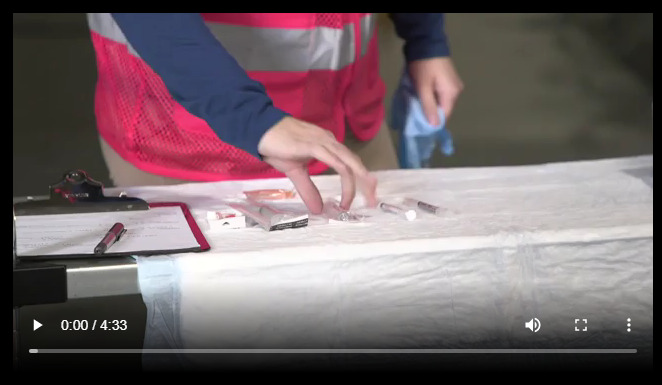
07/22/2021
Banner Health vaccination experts demonstrate the correct handling of COVID-19 vaccine at demonstration at the Arizona State Fairgrounds in central Phoenix.
-
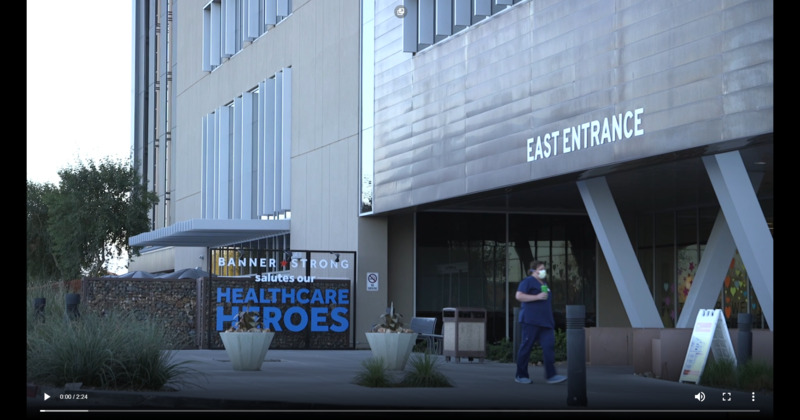
07/22/2021
B-roll of Banner Estrella Medical Center in west Phoenix where more than a thousand COVID-19 patients have been successfully treated during the pandemic.
-
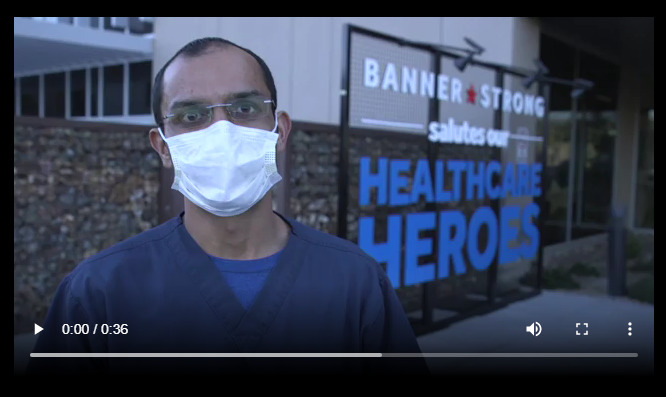
07/22/2021
Pritesh Patel, MD, speaks about what it was like to provide ongoing care for COVID-19 patients and families at Banner Estrella Medical Center in west Phoenix.
-

07/22/2021
Sarah Asel, RN, talks about what it is like to care for COVID-19 patients and the joy she experiences as one returns to thank her and colleagues for their care.
-
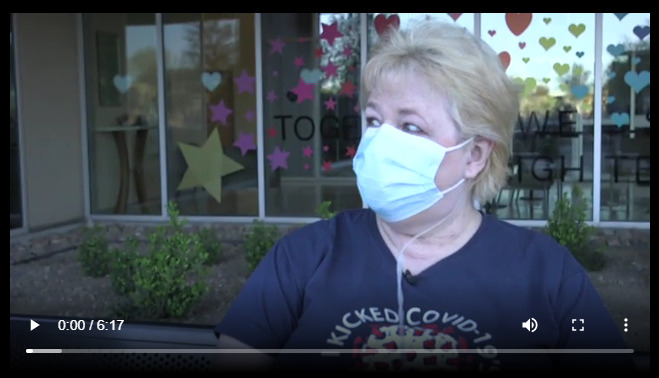
07/22/2021
Debbie Olsen, a former COVID-19 patient, returns to say thank you to the "life-saving'' doctors, nurses and staff who treated her for this life-threatening virus.
-
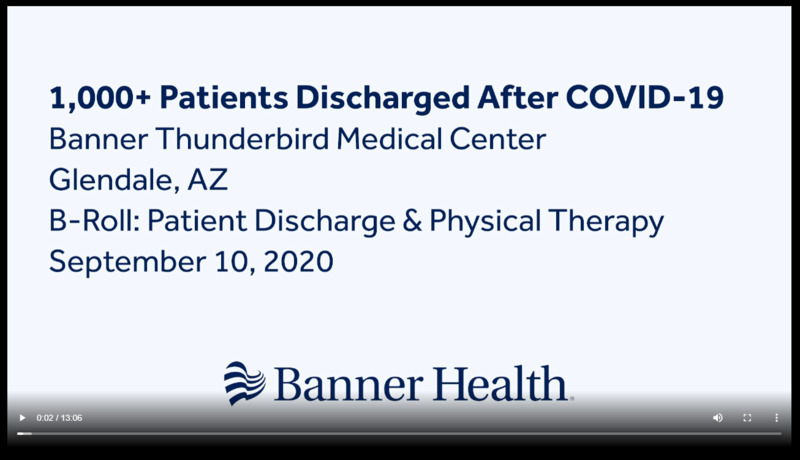
09/10/2020
Both Banner Estrella and Banner Thunderbird Medical Centers celebrated 1,000+ lives saved from COVID-19. Each hospital reached that milestone within a few days of each other.
-
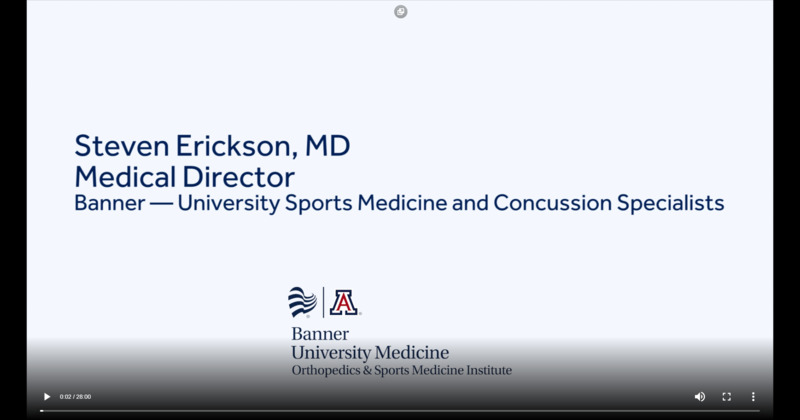
07/22/2021
Interview with Medical Director Steven Erickson, MD, as well as a physical therapist and a patient about COVID-19 effects on myocarditis, including diagnosis and treatment.
-
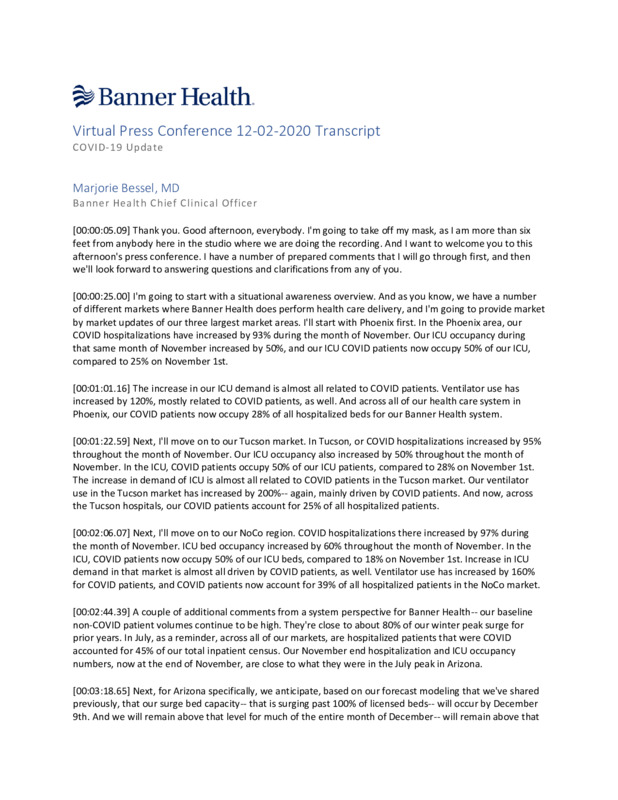
12/02/2020
Marjorie Bessel, MD, chief clinical officer at Banner Health, provides a system-wide update on Banner's response to the COVID-19 surges in many of the states it serves.
-

12/08/2020
Marjorie Bessel, MD, chief clinical officer of Banner Health, talks about the pandemic, increasing numbers of hospitalizations and what to expect in coming weeks
-

12/18/2020
Marjorie Bessel, MD, chief clinical officer of Banner Health, provides the latest updates on how the health care system is caring for a patient surge during the COVID-19 pandemic.
-

12/23/2021
Marjorie Bessel, MD, chief medical officer of Banner Health, provides an update about how the six-state healthcare system is handling teh COVID-19 surge.
-

12/30/2021
Marjorie Bessel, MD, chief clinical officer of Banner Health, gives an update on how the health system is dealing with the pandemic and the importance of masking up to contain the spread of COVID-19.
-

01/06/2021
Marjorie Bessel, MD, chief clinical officer of Banner Health, gives an update on how the health care system is managing the COVID-19 surge in six states.
-

01/12/2021
Marjorie Bessel, MD and other metro Phoenix health leaders discuss how their health systems are handling the challenges of Arizona's record number of cases.
-
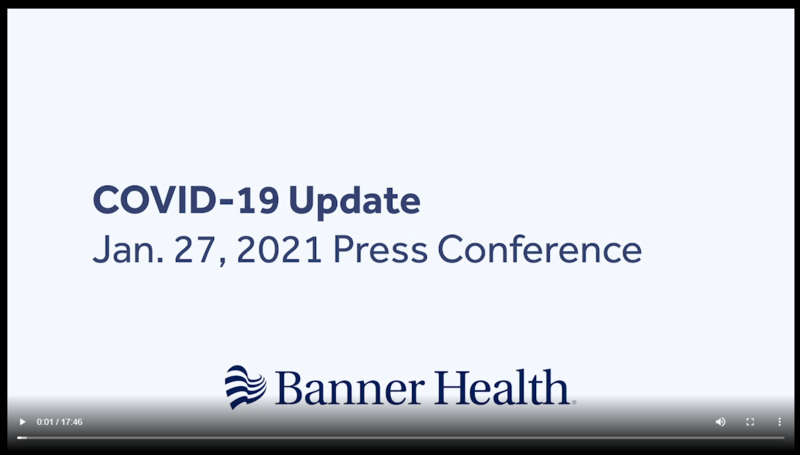
01/27/2021
Marjorie Bessel, MD, chief medical officer of Banner Health, talks about the need for vaccination and social distancing as Arizona experiences slightly fewer COVID-19 cases.
-

02/03/2021
Marjorie Bessel, MD, chief clinical officer of Banner Health, talks about how Banner is handling with the COVID-19 pandemic and that the health system has vaccinated more than 125,000 people
-
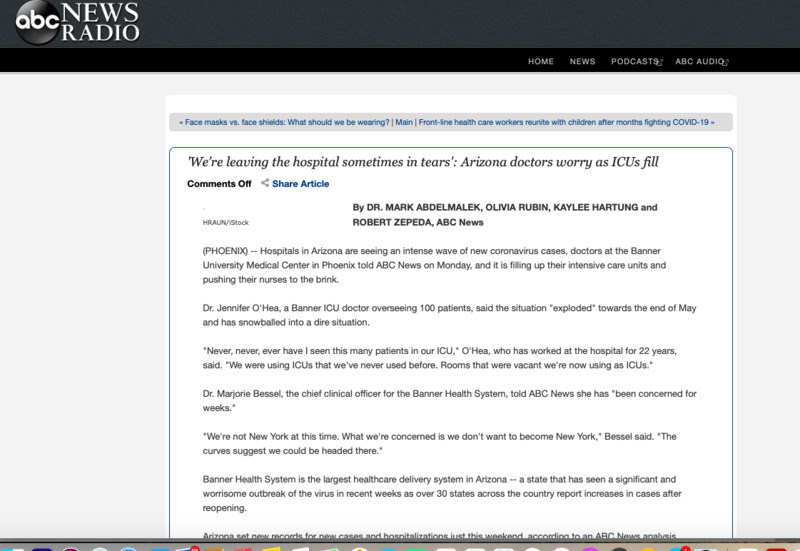
2020-06-30
(PHOENIX) -- Hospitals in Arizona are seeing an intense wave of new coronavirus cases, doctors at the Banner University Medical Center in Phoenix told ABC News on Monday, and it is filling up their intensive care units and pushing their nurses to the brink.
-
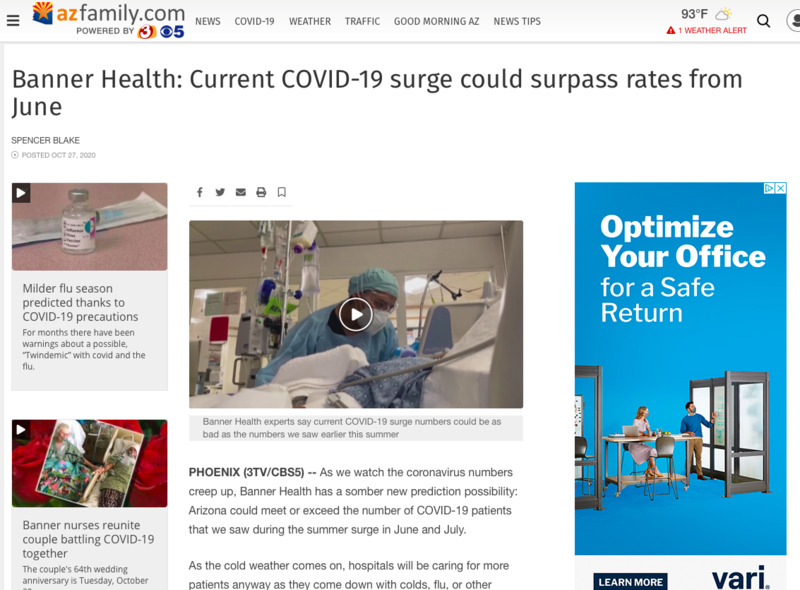
2020-10-27
Preparing for a surge; Banner warns that things could be worse than in the summer.
-
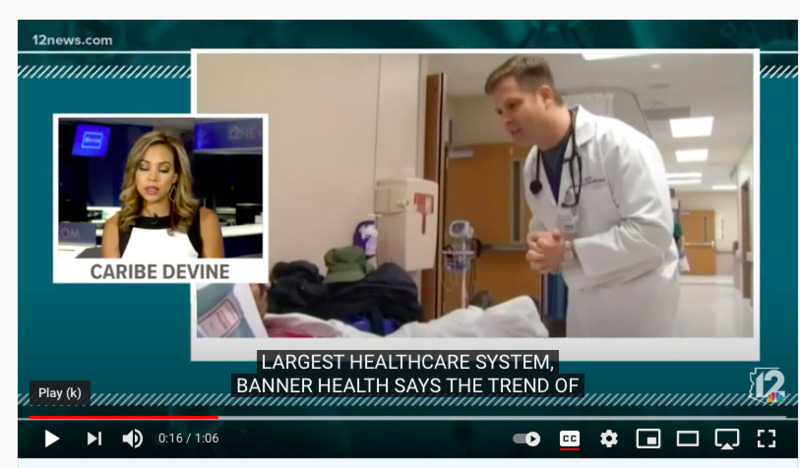
2020-06-05
Banner Health Chief Clinical Officer Dr. Marjorie Bessel told media Friday that intensive care units in Arizona were very busy.
-
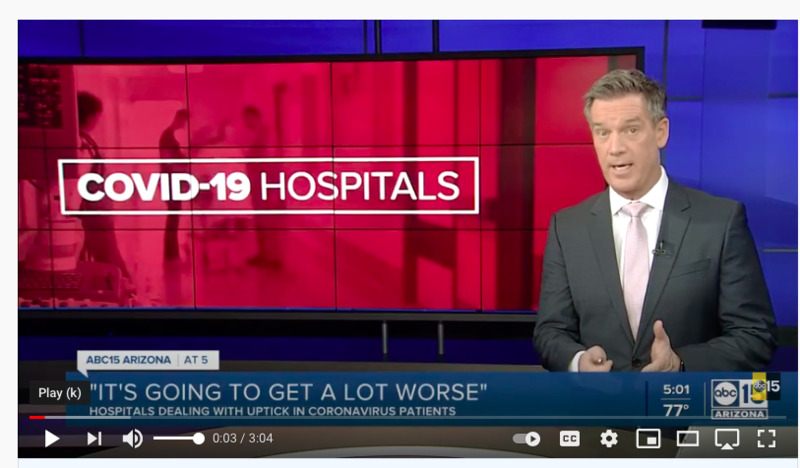
2020-12-09
Some doctors around the state are sounding the alarm on the number of available hospital beds - or lack thereof - as coronavirus cases surge.
-
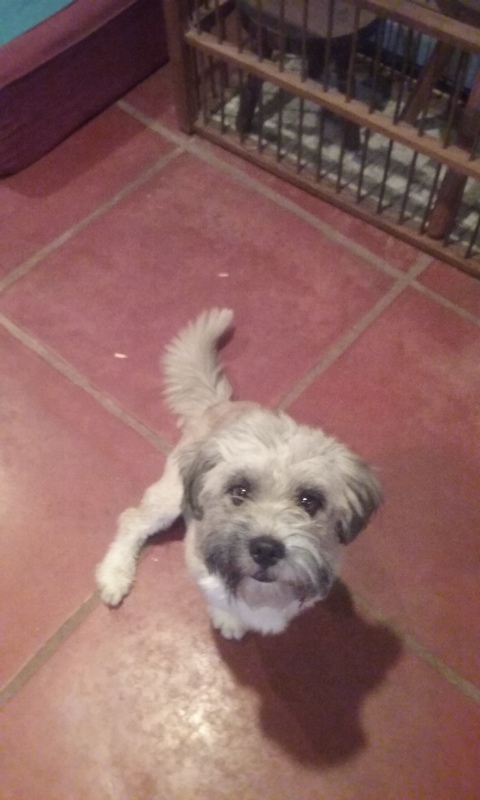
2021-06-03
The story describes the difficulties of dealing with emergencies during the pandemic time and how social isolation negatively affects one's ability to weather these emergencies.
-
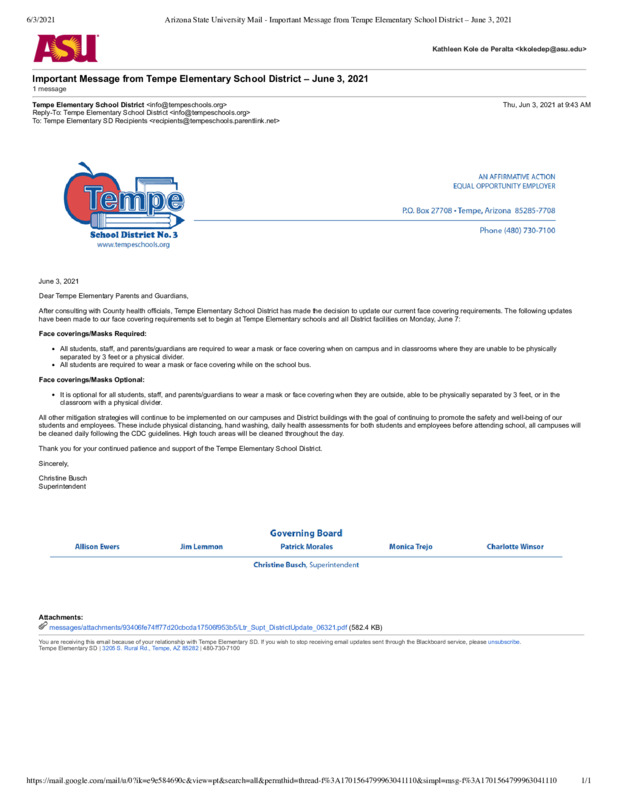
2021-06-03
My daughter is attending 3 weeks of summer school for PACE training. It's basically a test to determine if your child deserves extra resources for gifted students. When she goes to campus on Monday, she won't need a mask unless she's within 3 feet of other students. It's incredible to see how dramatically policies and infection rates have shifted behaviors. The vaccine seems to be keeping infection rates low. She has the chance to regain a little bit of normalcy.
-
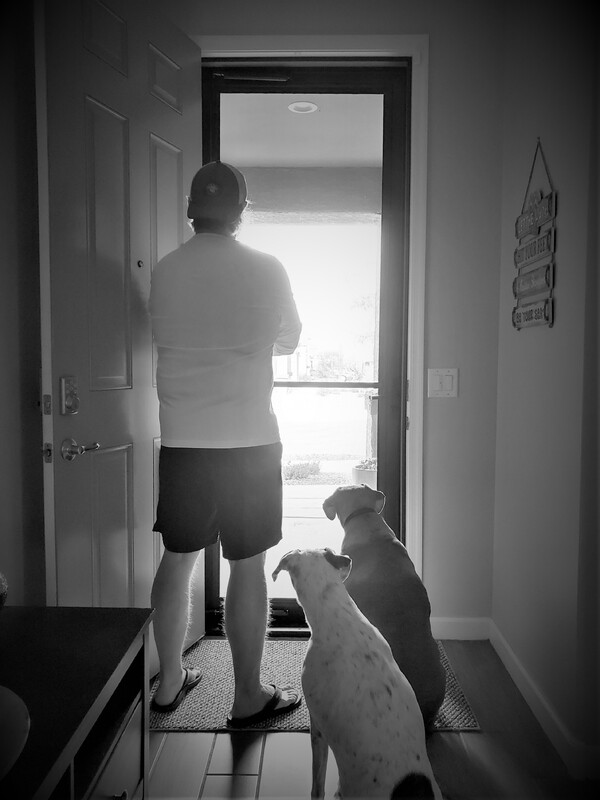
2021-04-21
--Reflections on the Pandemic Archive--
Looking back over my experience with the “Journal of the Plague Year” COVID-19 archive, my prevailing emotion is gratitude. This opportunity granted me experience that few historians earn, and the remote, asynchronous work schedule allowed me to collaborate with my colleagues in ways that maximized our respective contributions. The breadth and depth of our individual experiences and perspectives tremendously improved our collective process and products.
I spent enough time in the Arizona State Archives last year to recognize such collections as historical treasure chests, but I have now participated in processing an archive’s content and navigating the ethical dilemmas those submissions sometimes create. Archivists and curators are the history profession’s truly unsung heroes, and their work facilitates society’s perception of itself.
My background in police work and public safety drew me to the archive’s existing Law Enforcement collection. In taking on that subset, I succeeded in reshaping the collection’s parameters to now include stories about police and law enforcement. I wanted to diversify the collection to encompass perspective of both the police and the public with whom they interact and serve. While some overlap exists between the Law Enforcement and Social Justice collections, each remains distinct. Through my contacts and writing, I promoted a Call for Submissions to an international audience of law enforcement professionals to reduce their relative silence within the archive.
Within the archive’s content, I recognized that one’s location might shape their pandemic experience, and I created and designed an Arizona-based exhibit to explore that. Further research and discussion with my mentors and colleagues ensured the exhibit illustrated these differences without excluding visitors whose diverse experiences could further enrich the archived and exhibited content. I am proud of my “Arizona’s COVID-19 Pandemics” exhibit, particularly because of its compressed, one-month incubation period. Beyond displaying images, data, and stories representative of the diverse pandemic experiences within the state, the ACP exhibit offers visitors numerous levels of interaction and engagement to became active participants and create their own exhibit experience. Visitors can complete opinion surveys, add a story to the archive, explore additional content related to the displayed pieces, view ever-changing results from pre-defined archival content searches, conduct their own archival search, view collective visitor survey results, and apply to join the staff. The exhibit’s searches will include the archive’s future submissions, which reshapes both the exhibit and the experience visitors may have with it.
A more detailed explanation of my ACP exhibit may be reviewed here: https://covid-19archive.org/s/archive/item/43037
Because of Dr. Kathleen Kole de Peralta and Dr. Mark Tebeau, I stand prepared to join research, curation, and exhibition teams and immediately contribute to their work products.
Despite my gratitude for this experience and the opportunities it presented, I look forward to the day COVID-19 is no longer part of humanity’s daily vernacular.
James Rayroux
22 April 2021
-
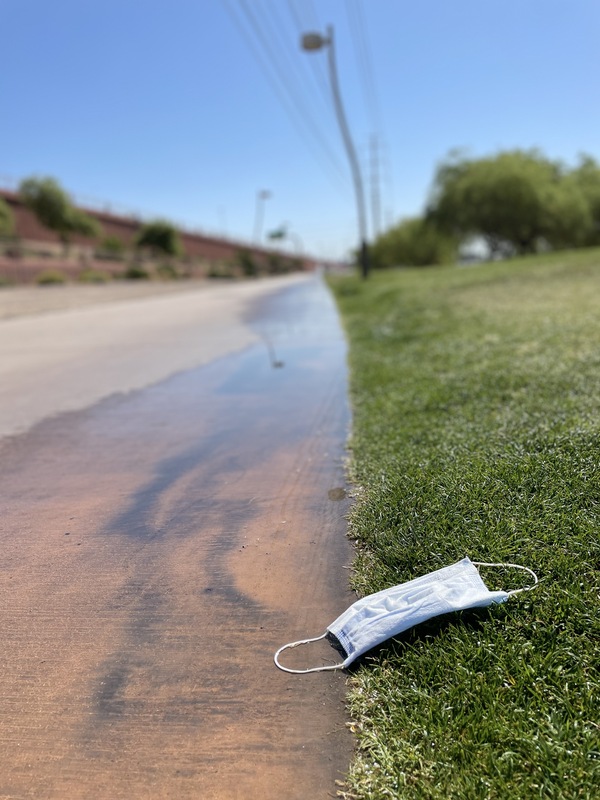
2021-04-20
Disposable mask along the riverwalk on the north bank of Rio Salado near the volleyball courts.
-

2021-04-20
Black disposable face mask floating in the Rio Salado River near Tempe Beach Park.
-
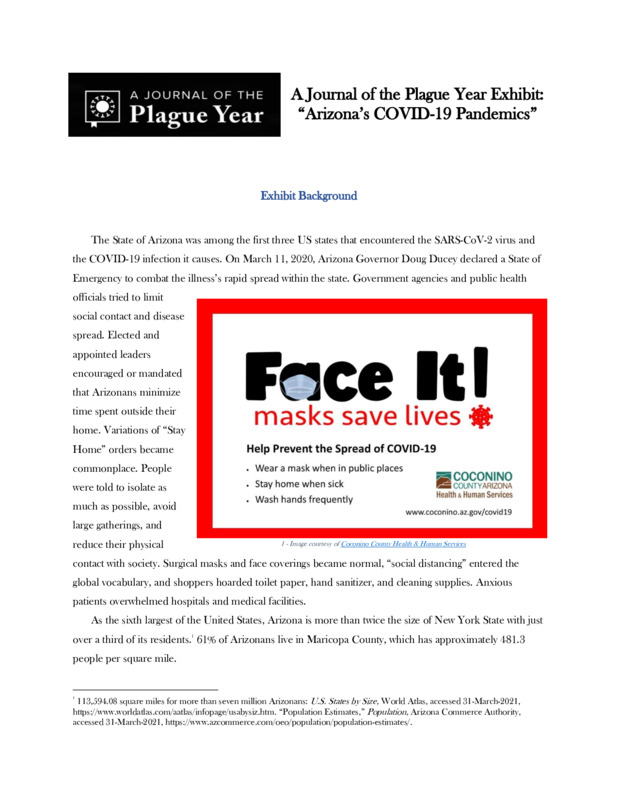
2021-04-20
While working as a curatorial intern on ASU's 'A Journal of the Plague Year' COVID-19 archive, I created this exhibit on the pandemic experience within the state.
In addition to obvious, overarching realities such as socioeconomic status and immediate access to healthcare systems, I initially believed one of the greatest deciding factors that determined one's experience in Arizona was an individual's residence in either predominantly urban or rural environments. The proposed exhibit had been originally titled "A Tale of Two Arizonas" to pay respect to Charles Dickens and the differing realities experienced here.
To test my proposed hypothesis, I went about finding data, stories, and submissions that substantiated or disputed my premise. Within a short time, I had identified four distinct environmental drivers of personal pandemic experiences; to me, that indicated the existence of many more I hadn't yet found or had overlooked along the way. My evidence suggested a minimum of four pandemic locales: Urban, Rural, Border, and Tribal within the State of Arizona and its fifteen counties. The recorded health data and personal experiences demonstrated the naivete of my initial hypothesis, and I retitled the exhibit: "Arizona's COVID-19 Pandemics."
The Exhibit Background section illustrates the vast dichotomies within Arizona in terms of population density and access to healthcare facilities. Given the virus's respiratory nature, these factors seemed especially relevant to driving diverse local experiences. I chose to include a flyer from the Coconino County Health and Human Services' "Face It! Masks Save Lives" campaign. The flyer included a specific line to "Stay Home When Sick" that seemed to illustrate a different public health paradigm than the broader "stay home" orders from Maricopa and Pima county. This section also features an image of Sedona's red rocks and a portion of The Wave to remind visitors of the wide-open rural areas accessible to all, as well as those with cultural significance to the Native American tribes and limited access to the general public.
The next section asks a short, five-question survey in which visitors may participate.
The Silver Linings piece features a short audio clip of a father and husband discussing some unexpected benefits of the pandemic. Visitors may explore additional Silver Linings stories and submit their own experience.
The Tséhootsooí Medical Center piece seeks to illustrate the different pandemic experience on the state's tribal lands. I hoped to inspire some relevant emotional turmoil for the visitors through the piece's visual presentation. I wanted to create a series of waves with quotes from the medical center's healthcare workers. I hoped visitors' attention would be drawn to the large, bolded key words, and that they would first experience the segments out of sequence because of that. After potentially feeling a sense of chaos, they might settle themselves into a deliberate reading of the texts and find their own order within the experiences provided here. This piece allows further exploration of Native submissions and topics, a review of an additional related news article, and a submission prompt that invites visitors to offer guidance to hospital managers.
The next piece illustrates the differences between mask mandates in communities across Arizona. In addition to hearing an audio clip of interviews with mayors and a public health official, visitors can explore additional submissions related to mask mandates and submit their thoughts on statewide mandates.
The Arizona Department of Health Services provides zip-code specific infection data on its website, and the wide array of known case infections therein further illustrates potential dichotomies across the state. In working to include and represent this data in a consumable way, I encountered inconsistencies with tribal data. The nation's Indian tribes are overseen by Indian Health Services, a federal public health agency, and it does not collect or report data in the same manner as the State of Arizona or its counties. At first glance, the data would seem to suggest that tribal areas had less severe pandemic experiences than the rural and urban areas, which was not objectively true. I wanted to offer the unedited data to visitors, allow them to drawn their own conclusions, and invite them to offer their thoughts on what potential misunderstandings might emanate from these reporting differences. Visitors may also choose to review the foundational data from this piece, as well.
I used the following two sections to offer submission prompts about the visitor's overall pandemic experience as a function of their location, as well as what they might have done if placed in charge of their city, county, or state during this pandemic.
A diverse Search section allows visitors to explore additional topics of interest to them. 23 hyperlinks offer pre-defined search parameters. An Advanced Search link allows self-defined research, and a Join The Staff link connects visitors with opportunities to work within the JOTPY archive.
A final section asks visitors to provide feedback on the exhibit, its content, and the pandemic in general.
Both surveys within the exhibit will display overall results to visitors who participate in them.
Through this process, I found incredible amounts and diversity of data outside the archive that spoke to these generally localized experiences, but not that much yet within the archive explained what Arizonans had experienced outside the state's urban environments. I created a call for submissions and delivered it to fifty rural entities that might help support the effort to collect and preserve more rural Arizona stories. Between all the local libraries, historical societies, museums, small-town mayors, and county health officials to whom I asked for help, I am optimistic the archive will better represent all Arizonans in the coming months and years. Despite the exhibit having been created, I ensured its internal search features would include future submissions and allow the exhibit to remain relevant long after its release.
-

2021-04-20
During March and April 2021, I created an online exhibit from content within Arizona State University's "A Journal of the Plague Year" COVID-19 archive. Entitled "Arizona's COVID-19 Pandemics," the digital exhibit contained images previously submitted to the archive, along with several copyright-free images I found on pexels.com. I have attached all these images. Listed by their order of appearance within the exhibit, their sources are as follows:
1- "Face It" Campaign flyer: Coconino County Health & Human Services ( https://covid-19archive.org/s/archive/item/42998 )
2- Red Rocks, Sedona: Courtesy of Gregory Whitcoe via Pexels.com
3- Online Learning: Courtesy of August de Richelieu via Pexels.com
4- Tséhootsooí Medical Center staff: Courtesy of FDIHB Marketing Department and Navajo Times newspaper ( https://covid-19archive.org/s/archive/item/41189 )
5- Arizona's Mask Mandate Map: created by Sarandon Raboin ( https://covid-19archive.org/s/archive/item/26267 )
6- Arizona COVID-19 Infection Zip Code Map: Courtesy of Arizona Department of Health Services ( https://covid-19archive.org/s/archive/item/42035 )
7- Woman Shopping: Courtesy of Anna Shvets via Pexels.com
8- Woman on Rural Arizona Road: Courtesy of Taryn Elliot via Pexels.com
9- Masked Woman in Crowd: Courtesy of Redrecords via Pexels.com
10- The Wave: Courtesy of Flickr via Pexels.com (this image is found only in the PDF submission of the exhibit, not in the public-facing exhibit itself due to document formatting technicalities - the PDF version can be found at https://covid-19archive.org/s/archive/item/42998 )
-
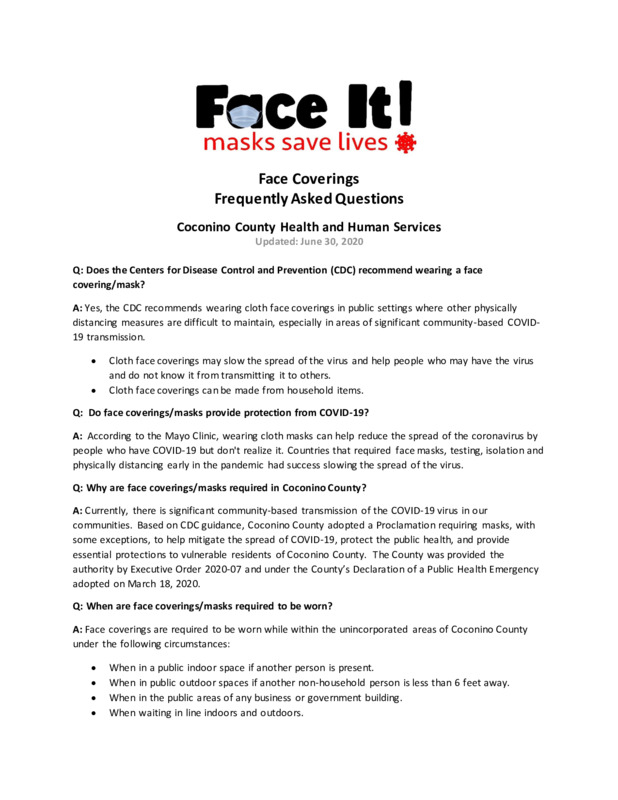
2021-04-20
The Coconino County Health & Human Services department created its "Face It" campaign in 2020 to promote the use of masks and face coverings in their communities. The following webpage is for the campaign's digital "toolbox" to give the public access to official signage for display to customers, the public, and employees to address mask use issues.
-

2021-04-19
These eight documents are the eight Public Health Emergency Orders issued by the Navajo Department of Health issued through 19 April 2021.
-
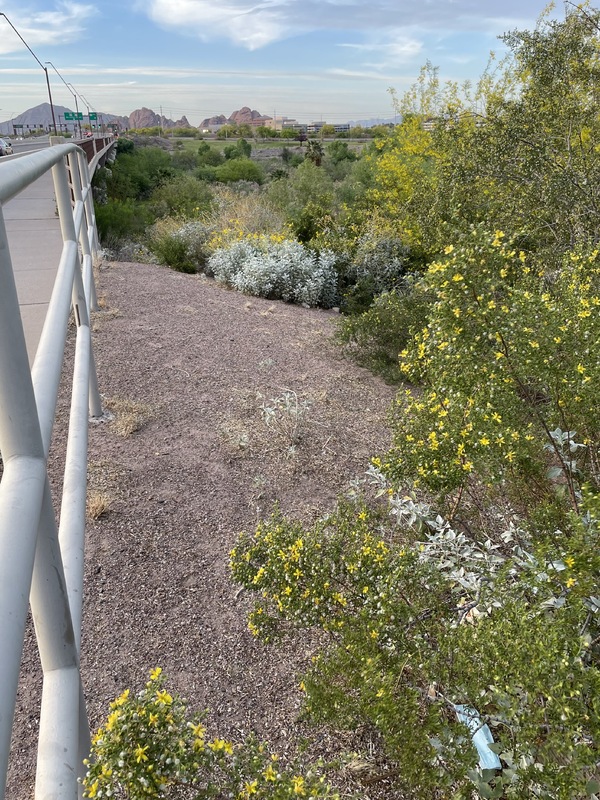
2021-04-19
Blue and white disposable mask trash caught in the shrubs off to the side of Priest and near Rio Salado.
-
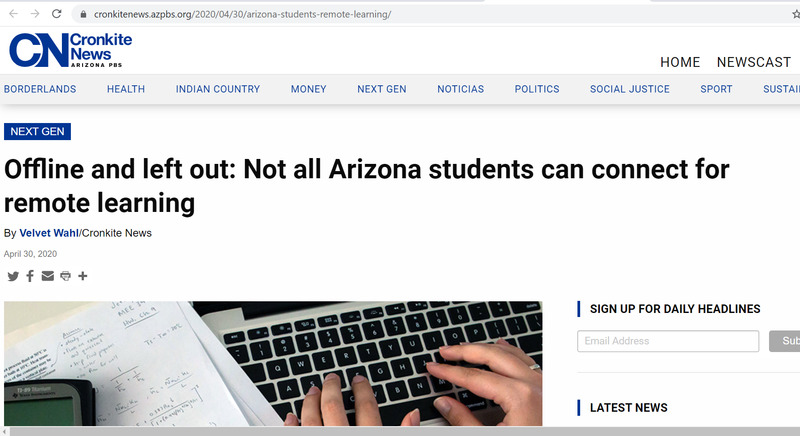
2020-04-30
This article focuses specifically on Arizona's efforts to provide students with internet/technology access in order to achieve online learning. It goes into detail about how several Phoenix schools dealt with the pandemic and online learning in the spring semester of 2020 as well as discusses how some students dealt with internet access issues in creative ways, either due to lack of internet or hotspot issues. Some examples are utilizing hotspots or through just going to public areas despite quarantine conditions to complete schoolwork.
-

2021-04-18
what impact covid 19 has had on my son
-
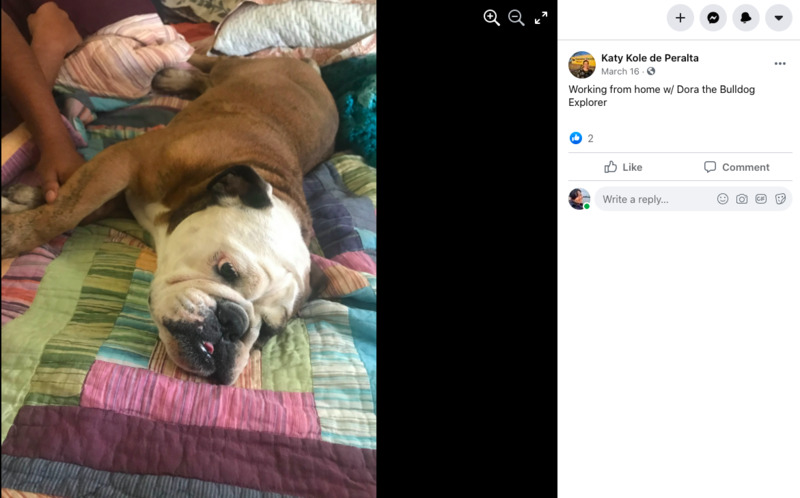
2021-03-16
Working from home w/ Dora the Bulldog Explorer
-
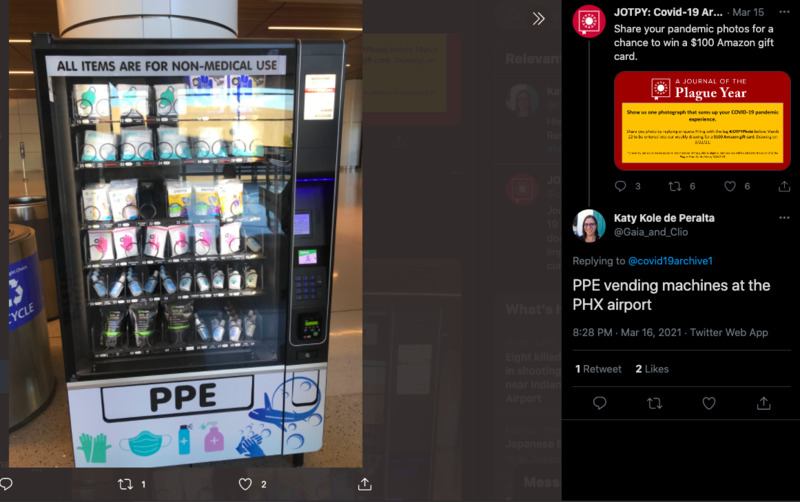
2021-03-16
PPE vending machines at the PHX airport
-
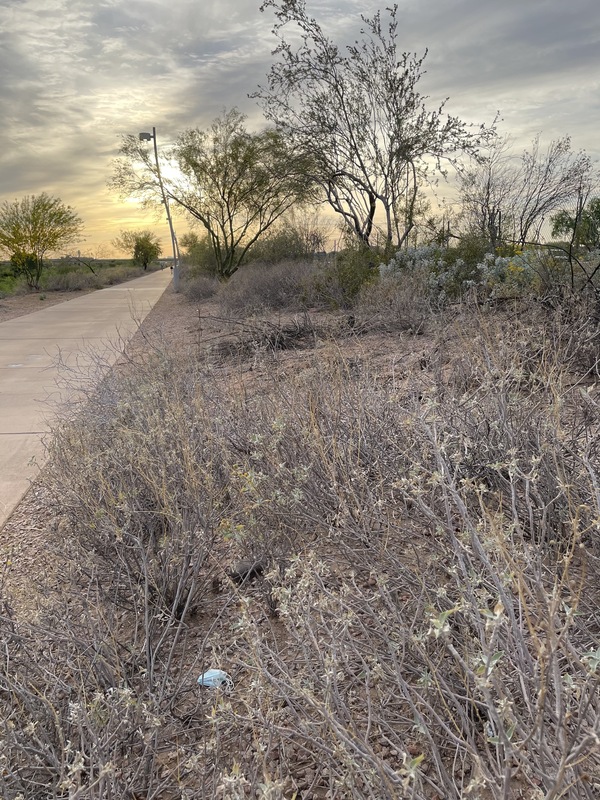
2021-04-15
Disposable mask found along the north bank of rio salado, near the 202 loop and Priest.
-
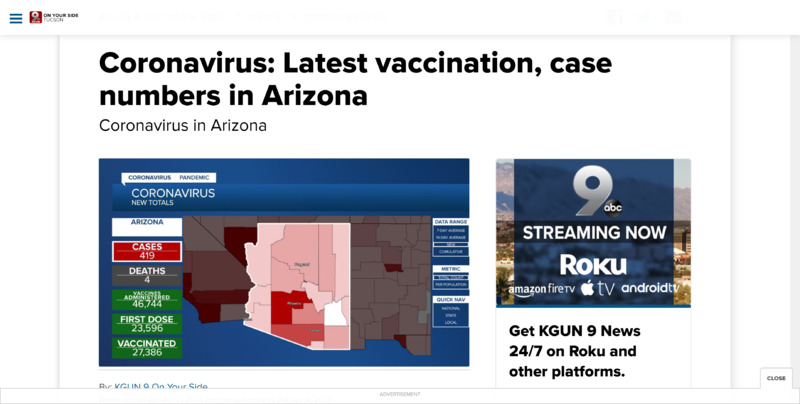
2021-04-14
Coronavirus in Arizona with Emphasis on local Pima County data:
By: KGUN 9 On Your Side - Posted at 11:36 AM, Mar 21, 2020 and last updated 9:03 AM, Apr 14, 2021
TUCSON, Ariz. (KGUN) — Editor's note: This article was first published on March 21, 2020. It is updated daily and refreshed with the latest updates and cases throughout Arizona.
Arizona Public Health officials are tracking the spread of coronavirus throughout the state. Here are the latest numbers provided by the Arizona Department of Health Services.
Last updated on April 14, 2021
FULL SECTION: CORONAVIRUS IN ARIZONA
Vaccinations in Arizona:
New doses reported today: 46,744
Total doses administered: 4,213,938
Total number of people who have received at least 1 dose: 2,611,983
Total number of people who have received 2 doses: 1,745,928
Percent of population vaccinated: 36.3%
Vaccinations in Pima County:
New doses reported today: 9,029
Total doses administered: 578,853
Total number of people who have received at least 1 dose: 363,431
Total number of people who have received 2 doses: 242,638
Percent of population vaccinated: 34.8%
Cases and Deaths through 04/14/2021:
Number of deaths: 17,109
Number of cases: 851,265
New cases: 419
New deaths: 4
Total number of tests reported: 8,835,798 (Diagnostic and Serology)
New tests reported: 17,381
Reported cases of COVID-19 by county:
Maricopa: 529,471
Pima: 113,903
Pinal: 50,417
Navajo: 16,018
Coconino: 17,398
Yavapai: 18,642
Cochise: 11,769
Graham: 5,520
Santa Cruz: 7,882
Yuma: 36,943
Apache: 11,256
Mohave: 22,353
La Paz: 2,450
Gila: 6,855
Greenlee: 568
Breakdown of cases in Pima County:
Total cases: 113,903
Deaths: 2,372
New cases: 81
New deaths: -1
-
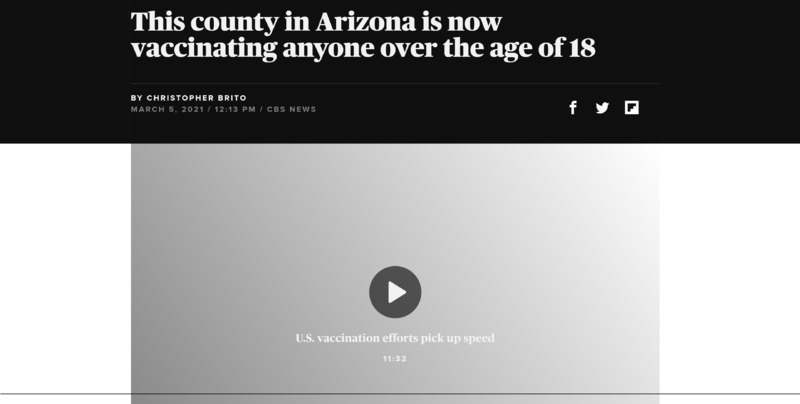
2021-03-05
"By Christopher Brito, March 5, 2021, CBSnews.com
While a majority of states and cities are still vaccinating higher priority groups of people, one county in Arizona is now allowing any resident over the age of 18 to receive the COVID-19 vaccine.
Gila County, which is located east of Phoenix, entered Phase 2 of their vaccine prioritization late last month, opening up eligibility to the general population.
Part of the the decision to open vaccine eligibility is because Gila County has one of the lowest percentages of COVID-19 vaccine doses used in Arizona. Michael O'Driscoll, director of Public Health and Emergency Management for the county, told CBS affiliate KPHO-TV that they received permission from the state last week to offer the vaccine in a drive-thru clinic last weekend.
"Prior to that, we were struggling to find enough people to make appointments to that, so the state gave me permission to offer it to any resident 18 and older," he said.
About 56,000 people reside in the county. According to the Arizona's Department of Health Services, more than 13,000 people – or almost one fourth of residents – have received at least one dose of the COVID-19 vaccine.
"We did a survey before to get a sense of how many people in Gila County would consider getting the vaccine, and our survey came back about 50-60% of the residents would choose to get the vaccine if available," O'Driscoll said.
Based on the data, over 5,600 people under the age of 65 have received the vaccine, including 73 people under the age of 20.
One of the younger recipients, 18-year-old Jacob Jost, told KPHO-TV that he was "excited" to get the shot.
"I have a little nephew, a little baby, so having the vaccine puts a peace of mind for that," Jost said.
First published on March 5, 2021 / 12:13 PM
© 2021 CBS Interactive Inc. All Rights Reserved.
Christopher Brito is a social media producer and trending writer for CBS News, focusing on sports and stories that involve issues of race and culture.
-
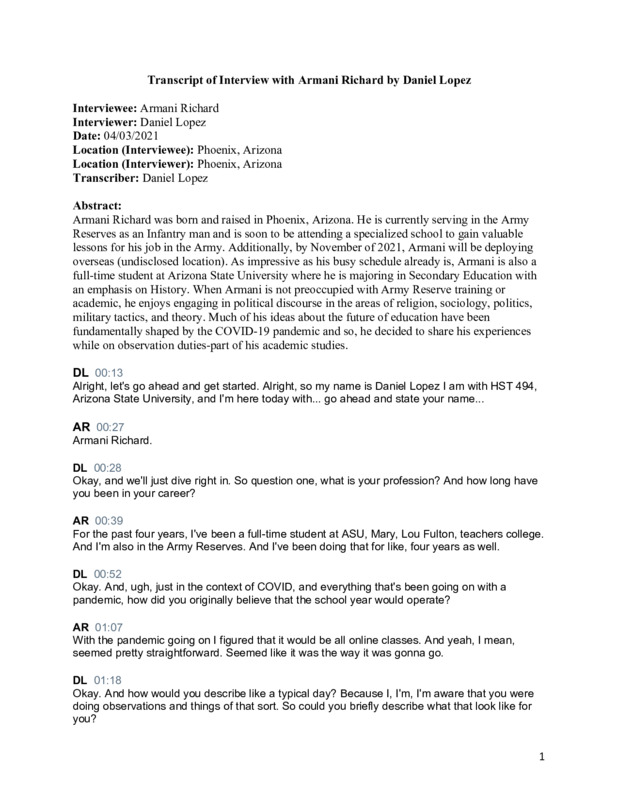
2021-04-03
Conversation with Armani Richard and the impact of COVID-19 on Arizona education. Currently studying at Mary Lou Fulton Teachers College and fulfilling a promising career in the Army.
-
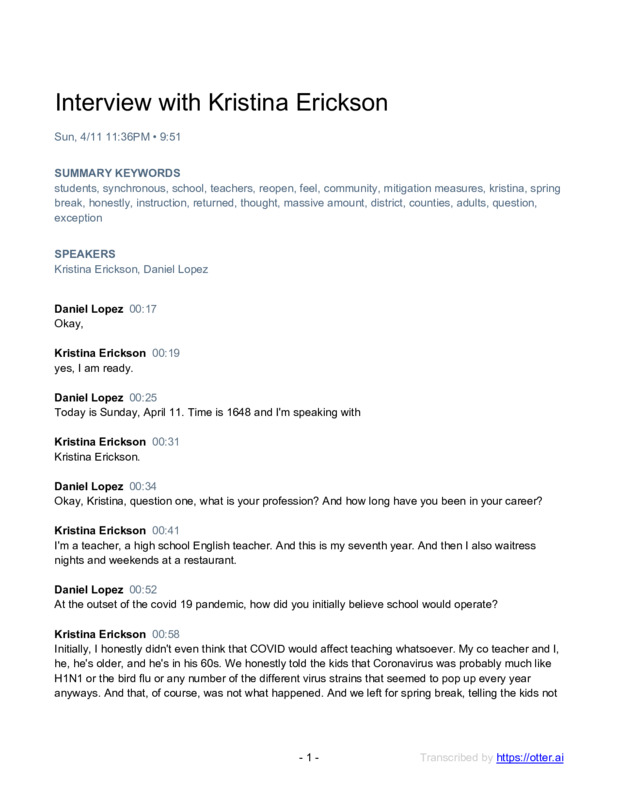
2021-04-11
Conversation with Kristina Erickson an Arizona K-12 educator. Ms. Erickson weigh-ins on the March 15th executive order, in-person instruction, COVID protocols and procedures, and the future of education in her community
 07/22/2021
07/22/2021 07/22/2021
07/22/2021 07/22/2021
07/22/2021 07/22/2021
07/22/2021 07/22/2021
07/22/2021 07/22/2021
07/22/2021 08/05/2020
08/05/2020 07/22/2021
07/22/2021 07/22/2021
07/22/2021 07/22/2021
07/22/2021 07/22/2021
07/22/2021 07/22/2021
07/22/2021 07/22/2021
07/22/2021 07/22/2021
07/22/2021 07/22/2021
07/22/2021 07/22/2021
07/22/2021 09/10/2020
09/10/2020 07/22/2021
07/22/2021 12/02/2020
12/02/2020 12/08/2020
12/08/2020 12/18/2020
12/18/2020 12/23/2021
12/23/2021 12/30/2021
12/30/2021 01/06/2021
01/06/2021 01/12/2021
01/12/2021 01/27/2021
01/27/2021 02/03/2021
02/03/2021 2020-06-30
2020-06-30 2020-10-27
2020-10-27 2020-06-05
2020-06-05 2020-12-09
2020-12-09 2021-06-03
2021-06-03 2021-06-03
2021-06-03 2021-04-21
2021-04-21 2021-04-20
2021-04-20 2021-04-20
2021-04-20 2021-04-20
2021-04-20 2021-04-20
2021-04-20 2021-04-20
2021-04-20 2021-04-19
2021-04-19 2021-04-19
2021-04-19 2020-04-30
2020-04-30 2021-04-18
2021-04-18 2021-03-16
2021-03-16 2021-03-16
2021-03-16 2021-04-15
2021-04-15 2021-04-14
2021-04-14 2021-03-05
2021-03-05 2021-04-03
2021-04-03 2021-04-11
2021-04-11